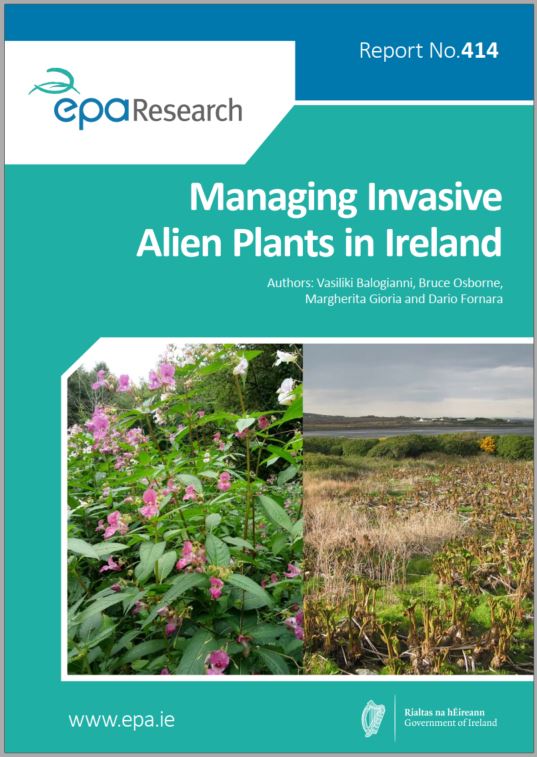Research 414: Managing Invasive Alien Plants in Ireland
Authors: Vasiliki Balogianni, Bruce Osborne, Margherita Gioria and Dario Fornara
Summary: The presence of invasive alien plant species across Ireland and Europe has increased significantly in the past few decades. The impacts of these invasions vary but they can lead to major modifications in ecosystem functioning. This research project has broadened our understanding of the ecological traits, strategies and impacts of invasive species. This information can be used in the management of invasive plants and help to inform legislation that might need to be introduced or strengthened.

Project Highlights
Watch the project highlights video
Identifying Pressures
The presence of invasive alien plant species across Ireland and Europe has increased significantly in the past few decades. The impacts of these invasions vary but they can lead to major modifications in ecosystem functioning, including alterations in nutrient cycling and carbon sequestration, habitat loss, species extinctions and decreases in native biodiversity. These impacts substantially affect several economic sectors, such as agriculture, tourism and construction. In Ireland, invasive alien species have caused major changes to native plant communities and ecosystem services, with some threatening not only disturbed habitats but also habitats of high conservation value. This requires further advances in best practice management for preventing the spread of new alien species and managing already invaded ecosystems to account for invader and site-specific effects. Management interventions that recognise the complex effects of plant invaders are becoming increasingly important given the increased global trade in goods and because people, together with global environmental changes, are predicted to promote the expansion of already naturalised populations and the introduction of new alien species.
Informing Policy
This research project has broadened our understanding of the ecological traits, strategies and impacts of invasive species. This information can be used to refine the way we deal with invasive plants (existing EU/national policy) or influence the types of legislation that might need to be introduced or strengthened (new policy initiatives). Our desktop studies detected a paucity of quantitative information on invasive species impacts on plant communities and ecosystems, highlighting the need for a significant investment in long-term research activities to protect Ireland’s biodiversity and ecosystems. Furthermore, our field and experimental studies showed that community and ecosystem impacts were invader dependent; thus, the importance of the invading species identity for management and restoration purposes cannot be overemphasised. Our seedbank studies indicated that restoration of areas invaded by Himalayan balsam might be quite fast and effective, as this species does not form a substantial seedbank and the number of native species in the seedbank were unaffected. In contrast, restoration of sites invaded by Chilean rhubarb may be more problematic and costly and take longer, on account of the loss of native species and the large and persistent seedbank formed by the invader.
Developing Solutions
The effective control of existing plant invaders requires the development of a coordinated all-island management strategy supported by appropriate resources and scientific expertise, to protect habitats of high conservation value and prevent further loss of biodiversity and ecosystem functioning and services. Given the results of the current study and ongoing environmental concerns, we have stressed the need for alternative site- and invader-specific approaches. Furthermore, based on the findings that Chilean rhubarb is not a very strong competitor during the early stages of establishment, the stage of invasion is an important consideration for management interventions and should be critically assessed and included in decision-making. We suggest that any control measures for Chilean rhubarb may be more effective if they are applied during the early stages of colonisation or during seedling recruitment, when plants are young and have a high mortality, taking advantage of their low probability of survival. We further highlight the importance of the maintenance of native vegetation cover, particularly early/late in the season, which has the potential to supress the survival and early growth of Chilean rhubarb seedlings.
https://www.epa.ie/media/epa-2020/research/epa-funded-research/Report-cover-414.jpg